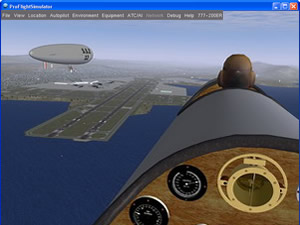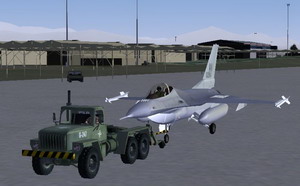 It's the next best thing to being up there!
It's the next best thing to being up there! ProFlightSimulator gives you the experience of flight right from your own computer. Everything from terrain, aircraft reactions, to planetary alignments & movements is based on actual world data.
The virtual controls are based on Real Life cockpits and you will find night flying more enjoyable with ground lighting concentrated in urban areas, car headlights on major roadways and accurate airport approach lighting. With realistic flight dynamics and controls,
It Doesn't Get Any Closer To The Real Thing!
With ProFlightSimulator, you can learn to fly without ever leaving your home. This is a HIGH quality, professional grade airplane flight simulator with the option to add scenery and airports that encompass the entire globe! Over 20,000 airports can be added with additional scenery sets.
How to Land a Plane in Flight Simulator 2004
Landing your airplane is the hardest part of flying in Flight Simulator. However, once you master landings, flying planes will be a lot more simple than you thought it is.
Steps
- Figure out at which airport you plan to land at. Then choose the runway on which you plan to land.
- Get your plane into a position that the runway you are landing at is directly ahead of you and the tip of the runway is facing you. You may not be able to see the runway just yet. If that's the case, then check your flight analysis to make sure you are in the right position. This position may take a lot of time and effort to get into but everything is easy after that.
- Pull back on your throttle and gently push forward on the stick. You should be going down at an angle less than five degrees but you should make your speed go down which will cause your plane to descent.
- Get near the runway you can adjust your angle of descent. If you are to low, then descent slower. If you are to high, then descent at a greater rate.
- Be very close to the runway, then even out your plane and pull back on the throttle gently, bringing it to idle. The back tires are suppose to lick the ground (softly.!).
- Slow down. After you are going slow, apply the brakes and finally the parking brake. Now you have stopped.
- Be proud of yourself because you have landed a plane which is very difficult.
- There is a certain Procedure for executing a normal Landing. The basic difference is a Visual Approach and ILS Instrument Landing Sys.
- Figure out the Nav frequencies of your runway and tune it. Press NAV in Autopilot for it to guide you through the Glide Slope & Localizer. At decision Height (200 ft generally for the ILS) disengage autopilot, Idle Thrust, arm auto brakes and flare. Engage reverser after the nose wheel touches the runway and apply Speed Brakes '/' key.
- Good Luck.
- Now you should be on the runway.
Tips
- Land on a runway on which you are sure your plane will have enough room to stop.
- Watch your Attitude indicator (artificial horizon) and Vertical speed indicator (VSI) to see at what angle you are going during the descent.
- Get the information about the airport's runway by clicking on the airport on the flight analysis map.
- It is much easier to land (and fly in general) if you use a joystick rather than the keyboard.
Warnings
- Do not apply brakes too quickly or your plane might flip over.
- If you descend too quickly you might crash.
- If you don't follow the steps correctly your plane might crash
- Remember that most plane crashes happen on landings. Be very careful.
Things You'll Need
- Computer
- Flight Simulator 2004




No comments:
Post a Comment